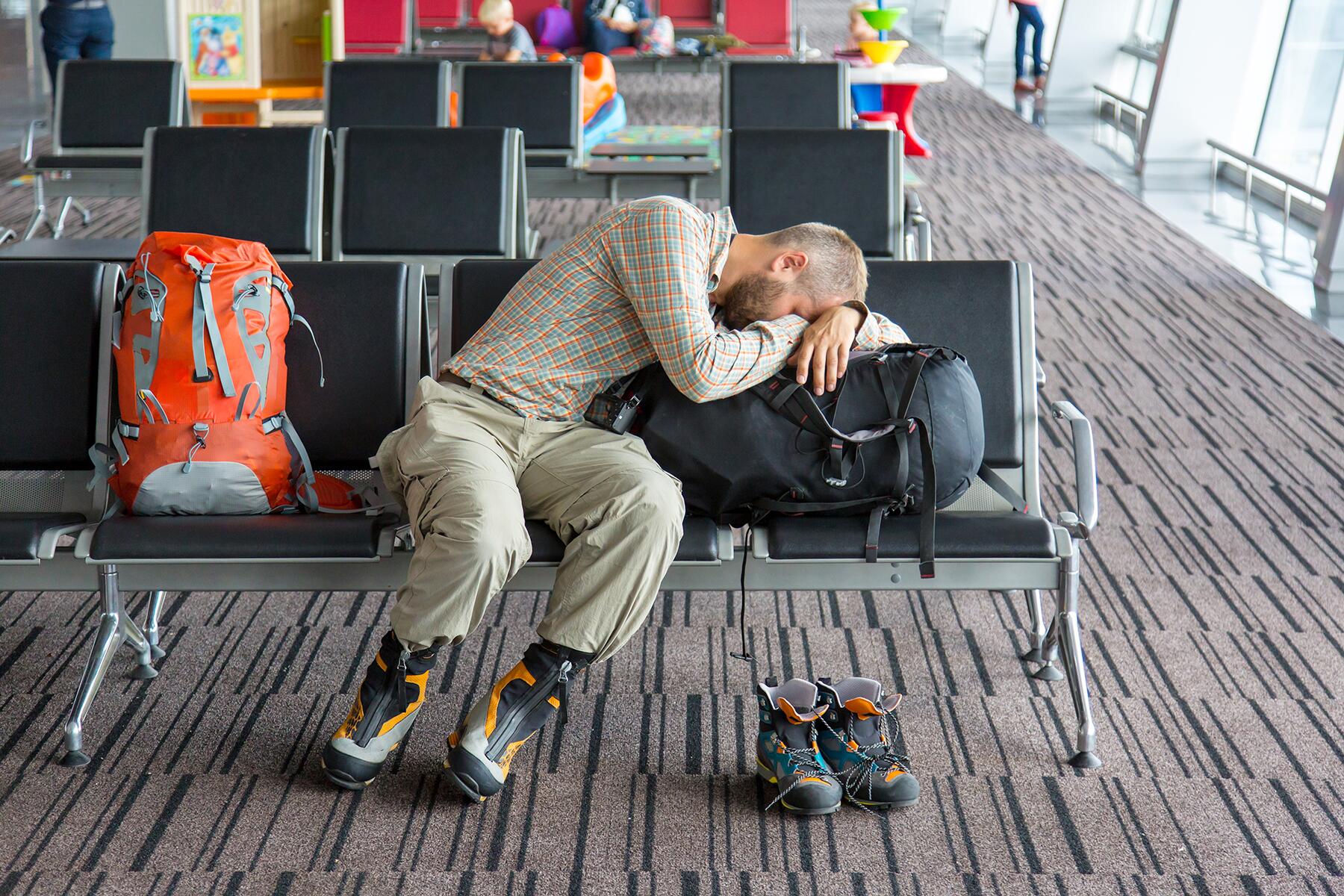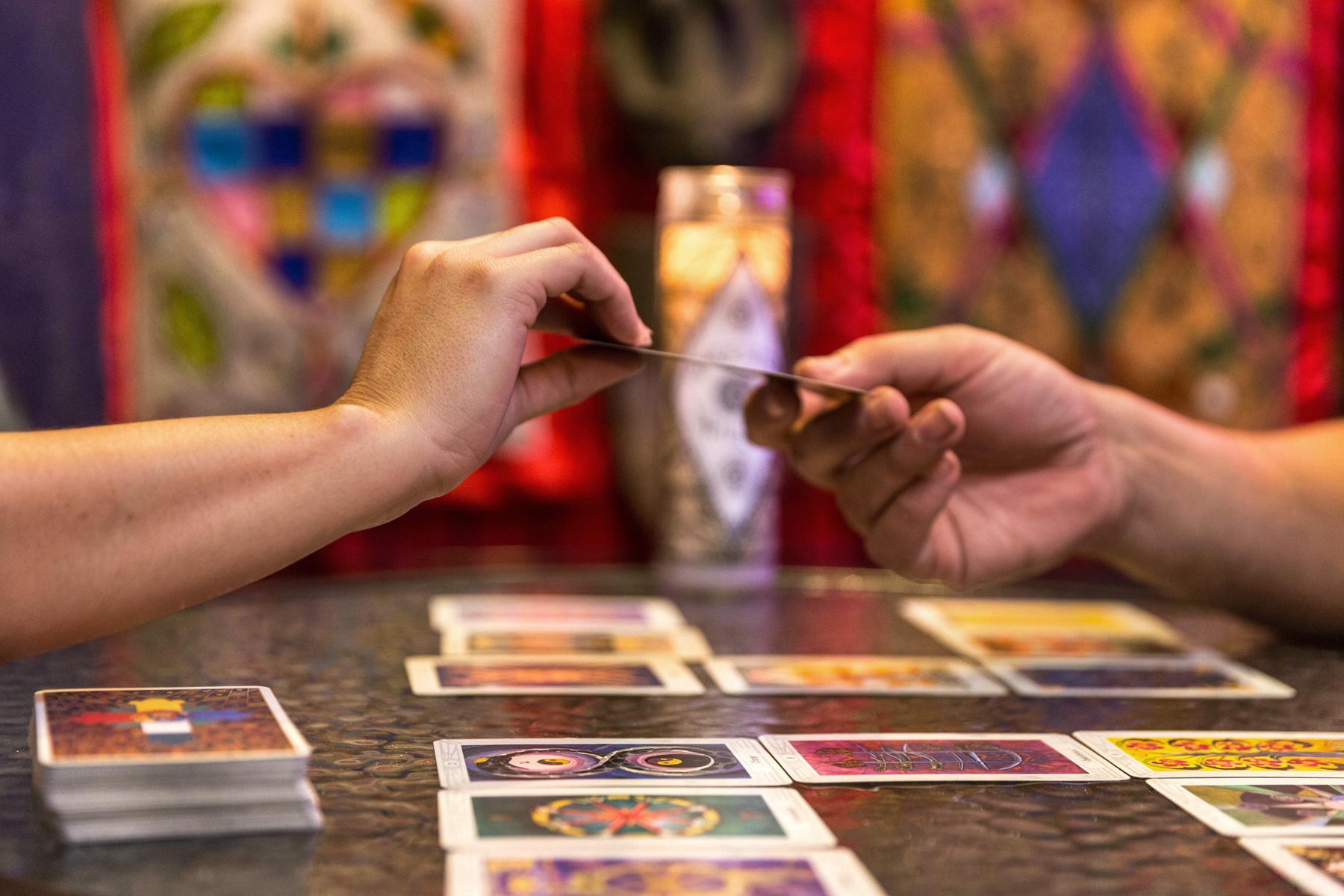Physical travel may be a no-go, but metaphysical practitioners are offering guided tours to the other side.
The mid-April sun hung high in the sky and soon a waning crescent—a pensive phase of reflection and letting go—would rise in the clear skies above Tacoma, Washington.
Inside her apartment, Oracle Mary Alexa Woodard zoomed around, ransacking closets and turning rooms inside out. She could not find her cloak.
The Oracle needed the velvet garment to complete her ensemble and add gravitas to the flirty deep-V-collared dress she’d donned for the occasion. The cloak’s blood-red lining was the perfect foil for her white-and-teal-accented copper jewelry, and it picked up the color of the eyeshadow she had powdered up to her temples.
Finally, her girlfriend came to the rescue, ushering her to the back of the front closet where the cloak had hidden itself behind a coat.
With her uniform now complete, the Oracle rushed back to her desk, shoving aside a pile of books and drying seashells to make room for her tarot cards. She lit a purple tealight and carefully laid out her cards—the “Medieval Cats” deck. Then, she crossed the threshold into her first virtual house party.
Top Picks for You
Recommended Fodor’s Video
Over the next three hours, Woodard led 15 clients on virtual tours of their own internal landscapes. It was her first time reading for people who weren’t physically in the same room, but despite the distance, Woodard said the readings still transported them to the otherworldly headspace for which tarot is so well known.
“There’s just a temporal element that is very strange with both travel and tarot…where you’re both a part of society and outside of it,” Woodard said later. “[It’s a] similar liminal space.”
It’s About the Journey, Not the Destination
The quintessence of travel is engaging with people, places, and experiences that exist outside the perimeters of our daily lives—but often it is the journey, more than the destination, which transforms us.
Perhaps that’s why, across cultures, journeys symbolize transition and transformation and are often a metaphor for deep internal work, both individual and collective. The Torah follows the exodus of Hebrew people from Egypt to the promised land of Canaan, a migration that is seminal to modern Jewish identity.
For the ancient Greeks, traversing the River Styx represented the soul’s movement to the afterlife. Even today, many devotees realize their faith through pilgrimages, such as performing the Islamic hajj or trekking the Lycian Way, inspired by ancient religious texts.
Then there is the afterlife: a nebulous space that is both a state of being and the final destination for the dearly departed—all at the same time. Variations on the heaven-hell-purgatory afterlife, and the journey to it, are visible in the three major Abrahamic religions.
In many Native, African, and African-American traditions the defining aspect of “the beyond” is the presence of ancestors. “In my cultures, we always were in communion with the ancestors and exercising our faith in the unknown,” says Chiiirp Vaypors, a witch and tarot reader, whose personal metaphysical practice and past-life work draws on her Native and African-American heritage.
The borders of all these lands are permeable. The living and the dead can both visit each other’s homes through dreams—as Vaypors does—religious rites, or guided spiritual experiences.
And that’s where people like Woodard come in.
“It’s this interesting position where I’m a conduit of others’ exploration while I’m a stagnant figure,” said Woodard. “You have cast me with being the ferryman, and I cast you on the Ferry Styx to Elysium…Those who fall off the boat or stumble to shore are the ones who don’t ask questions.”
Break On Through to the Other Side—Virtually
Coronavirus may have halted physical travel but it’s also made trips to the Other Side more accessible than ever.
Interest in spiritual services, everything from aura analysis to zodiac chart reading, was rising before the pandemic. Like wellness tourism, spiritual self-care is just one of many spin-offs of the $4 trillion dollar global wellness industry. In the United States alone, “psychic services,” is an ascendant $2.3 billion dollar market in its own right.
Many practitioners already had an online presence before coronavirus but social distancing has forced them all to transition their marketing and service delivery to an entirely online model.
“[A tarot reading] takes them out of themselves. It transports them, at least mentally, to a different time [and] a different place.”
Patti Woods LaVoie, a tarot reader for over 30 years, who used to book in-person appointments and parties, has pivoted her practice entirely to Zoom. Her weekly digital tarot night, “Boozy Tarot Sundays,” has soared in popularity during quarantine. Woodard estimates that she has performed 30 tarot readings in the past two months—the number she usually does in one year.
Mani Smart, a Gen Z spiritual advisor and astrologist, has seen firsthand the reach of a digital native spirituality practice. Although she offers one-on-one birth chart readings, Smart is best known for delivering divinations to followers through her Instagram, YouTube, Twitter, and Snapchat platforms. The sudden boom in the virtual spirituality industry tripled her Twitter following to over 150,000 in less than three months.
For the service providers and clients we talked to, overall, the transition to socially-distanced sessions has presented more opportunities than challenges.
Admittedly, virtual readings of all kinds lack the nuance of the in-person experiences, something Amaan Khan, a graphic designer in Mumbai, observed when he and his tarot reader, Maitreyi Bhatia, made the switch.
Clients also cannot touch the cards—or other implements like crystals or rune stones—a typical way of imbuing the deck with their energy, said Woodard.
Still, online sessions have their perks. There is less pressure on the reader to analyze quickly, so they can more thoughtfully guide their client. They can also keep reference materials at hand to help navigate particularly complicated interpretations, Woodard said. Chiiirp Vaypors, who has offered online readings since 2017, also noted in an email that online readings can be recorded, allowing clients to replay the session at a later date.
Emotional Labor, Spiritual Burnout
Despite these advantages to practitioners’ new normal, it’s still a tough job. Fortune-tellers, mediums, and readers all double as spiritual therapists, helping their clients traverse rough psychic terrain.
Bhatia, also based in Mumbai, said she limits herself to two tarot reading sessions per day to avoid emotional exhaustion. A reading is quite literally a business trip, no matter how enjoyable, said Woodard.
Managing potential burnout is especially critical during a time when lockdown is creating a demand for spiritual services among previously indifferent demographics, unleashing a deluge of clients.
“[I’ve] seen a lot of straight-laced, non-mystical, non-woo-woo kind of people [such as] soccer moms and grandmas,” said LaVoie, who is based in Connecticut. “[A tarot reading] takes them out of themselves. It transports them, at least mentally, to a different time [and] a different place.”
This is exactly why Sarah Prager, a freelance writer from Massachusetts, hired her (pre-COVID-19) massage therapist—who is also a Reiki healer and medium who once channeled Prager’s grandmother—to do a tarot consultation via Facebook video chat.
Though she says, “it is absolutely not the same” as a physical vacation, the reading was a journey “away from the mundane” a mini-break from the microcosmic grind of lockdown, which offered a positive glimpse at what her future might hold.
Other clients seek out readings specifically to continue an ongoing internal journey.
For Spiritism-skeptical student Sukirti Katiyar, coronavirus not only canceled long-awaited travel plans, it dredged up difficult memories of sheltering in place due to adolescent health issues. Seeking out a tarot reading with Bhatia was a way for Katiyar to cope with—not escape—this reality.
“I thought that part of my life was finally over and I had the chance to ‘explore’ the world,” Katiyar said in an email. “The cards helped me see the ‘good’ in self-isolation and rediscover my creative side.”
The emotional labor of embarking of these spiritual and psychic journeys foreshadows the kind of travel we are all likely to do in the near future.
As localities gradually reopen, travel will likely be less about congregating in specific selfie-worthy locales and more about the journey (by car). Arguably, this may be the best way to process what just happened to the world.
Until then, would-be travelers suffering from lockdown-induced wanderlust might want to enlist the services of an oracle like Woodard to take the edge off.
“Tarot is a way to take action and do movement through the metaphysical, not the physical,” said Woodard. “[It] matters more now because this is the travel, movement, and action people can take…a way to achieve that movement while being stagnant.”



